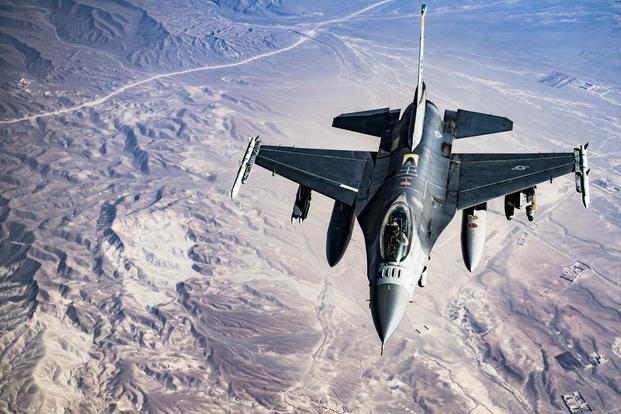The U.S. Air Force won't meet the Pentagon's goal of boosting readiness across its fighter fleets before the fiscal year comes to a close this month, a top general said Wednesday.
Lt. Gen. Mark Kelly, deputy chief of staff for operations, told audiences at the 2019 Defense News Conference that the only fighter that may make the 80% mission capable (MC) rate -- a standard set by then-Defense Secretary Jim Mattis last year to achieve better aircraft performance -- is the F-16 Fighting Falcon.
"The F-16 MC rate in our active-duty units is above 80%," Kelly said during a panel on Air Force prioritization, adding that the service is working with its Guard components to reach the goal.
The F-22 Raptor and F-35A Joint Strike Fighter fleets will come up short, he said, but for different reasons.
Related: The Air Force Is Ready to Scrap Older Aircraft to Prepare for Future Wars
The F-22's low-observable skin, which makes it stealthy, has been demanding to maintain. The F-35, meanwhile, has seen greater operational use even as bases are still standing up F-35 missions. The Air Force recently deployed a contingent of F-35s to the Middle East for the first time.
"We learned a lot from the MC effort," Kelly said, explaining it would be easy to achieve an 80% MC rate for its jets if only the Air Force would stop flying altogether.
"But we didn't do that during that time frame; we actually flew more. We've flown more every year since 2017 to give aviators more experience and have them more ready," he said.
Last October, Mattis ordered the services to raise mission-capable rates for four key tactical aircraft: the F-16, the Navy's F/A-18 Hornet, the F-22 and the F-35. The objective was to achieve an 80% or higher MC rate for each fleet by the end of fiscal 2019.
But the 186-aircraft F-22 fleet, for example, has been hobbled by a number of factors in recent years.
Last month, Gen. Mike Holmes, head of Air Combat Command, said additional maintenance facilities to fix the F-22's stealth coating could help boost its MC rate in coming years.
"We're looking at the longer-term options for addressing low observable [LO] maintenance facilities," Holmes said during a Defense Writers Group breakfast in Washington, D.C.
Hurricane Michael, which devastated Tyndall Air Force Base, Florida, last year, also took out its low-observable maintenance facility, he said. That backlogged crucial maintenance, which affected the fleet.
Following the storm, F-22s previously stationed at Tyndall were dispersed to other bases that host F-22 missions, such as Joint Base Langley-Eustis, Virginia; Joint Base Elmendorf-Richardson, Alaska; and Joint Base Pearl Harbor-Hickam, Hawaii. The flying training unit (FTU) moved on as well, and lawmakers are trying to persuade the Air Force to establish a permanent FTU at Langley.
But Langley may not have enough LO facilities to sustain more F-22s, Holmes said.
So "we're using a contractor-owned facility in Georgia [and] we're looking at reopening some of the facilities that were built at Holloman [Air Force Base, New Mexico] when we had F-22s there while we wait for the longer-term wrap-up of what will happen with the permanent home of the F-22 flying training unit," he said.
-- Oriana Pawlyk can be reached at oriana.pawlyk@military.com. Follow her on Twitter at @Oriana0214.
Read more: Pentagon Halts Work on Directed-Energy Beam to Stop Enemy Missiles













